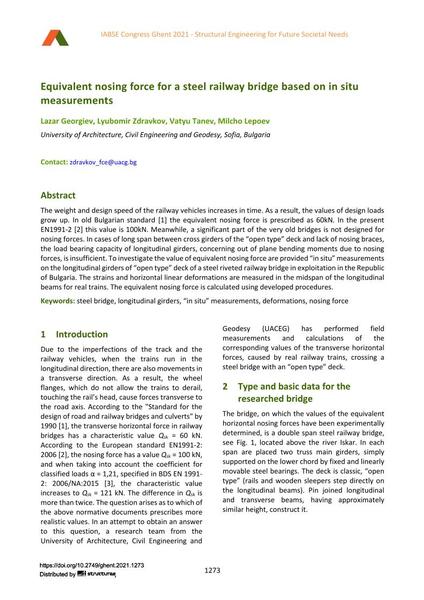Equivalent nosing force for a steel railway bridge based on in situ measurements

|
|
|||||||||||
Bibliographic Details
| Author(s): |
Lazar Georgiev
(University of Architecture, Civil Engineering and Geodesy, Sofia, Bulgaria)
Lyubomir Zdravkov (University of Architecture, Civil Engineering and Geodesy, Sofia, Bulgaria) Vatyu Tanev (University of Architecture, Civil Engineering and Geodesy, Sofia, Bulgaria) Milcho Lepoev (University of Architecture, Civil Engineering and Geodesy, Sofia, Bulgaria) |
||||
|---|---|---|---|---|---|
| Medium: | conference paper | ||||
| Language(s): | English | ||||
| Conference: | IABSE Congress: Structural Engineering for Future Societal Needs, Ghent, Belgium, 22-24 September 2021 | ||||
| Published in: | IABSE Congress Ghent 2021 | ||||
|
|||||
| Page(s): | 1273-1279 | ||||
| Total no. of pages: | 7 | ||||
| DOI: | 10.2749/ghent.2021.1273 | ||||
| Abstract: |
The weight and design speed of the railway vehicles increases in time. As a result, the values of design loads grow up. In old Bulgarian standard [1] the equivalent nosing force is prescribed as 60kN. In the present EN1991-2 [2] this value is 100kN. Meanwhile, a significant part of the very old bridges is not designed for nosing forces. In cases of long span between cross girders of the “open type” deck and lack of nosing braces, the load bearing capacity of longitudinal girders, concerning out of plane bending moments due to nosing forces, is insufficient. To investigate the value of equivalent nosing force are provided “in situ” measurements on the longitudinal girders of “open type” deck of a steel riveted railway bridge in exploitation in the Republic of Bulgaria. The strains and horizontal linear deformations are measured in the midspan of the longitudinal beams for real trains. The equivalent nosing force is calculated using developed procedures. |
||||
| Keywords: |
steel bridge deformations longitudinal girders in-situ measurements nosing force
|
||||
| Copyright: | © 2021 International Association for Bridge and Structural Engineering (IABSE) | ||||
| License: | This creative work is copyrighted material and may not be used without explicit approval by the author and/or copyright owner. |
||||
